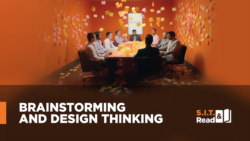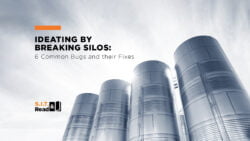Companies are all too aware of “silos” and the difficulty of sharing and collaborating among departments or units. They therefore embark on joint ideation exercises, that often end with disappointingly meager results. Why?
1. Sharing starts in meeting
An effective encounter of teams, be they warring tribes or (more difficult still) adjacent units in a corporation, requires meticulous preparation. Just throwing together people from different cultures doesn’t bring out the best in them. Minimum preparation includes defining what they would like to achieve in the meeting and what they are willing to contribute to its success, and (as detailed in #4 below) a sincere mapping of potential conflicts of interest.
2. Inter-unit meetings often start with mutual presentations of achievements
But listeners can usually put into practice very little of what they hear, due to limits to one’s capacity to absorb when passively listening, especially when the subject matter is, by definition here, not yours.
Facilitated properly, the session should consist of alternating presentations and interactive exercises. Presentations should be broken up into chunks, each followed by questions from the audience and the facilitator. Listeners should be encouraged to both interact with the presenter and take notes for use later when ideating.
3. Incentives and motivations to collaborate are not analyzed and aligned
Yes, we are all in this together, yes, we all know “it’s important to collaborate”, but what are the actual incentives to do so? Most chances are that if you present something of use to another of the participating units: a) they may end up doing better than your unit, b) they may use up even more of your time later, coming back with questions and additional requests, c) your boss will be unhappy with both (a) and (b).
While planning the silo-busting session ask yourself (and answer): apart from overall benefits for the organization as a whole, how can these specific units and participants be incentivized to share and collaborate? Can you keep score of “assists”? Celebrate those who share most? Formalize the accounting of knowledge-transfer between units?
4. Hidden agenda stays… hidden
I’ve often been asked to facilitate an encounter of two teams called upon to collaborate, in which all are aware that success for team A would entail damage to team B and/or vice-versa. Example: a successful product launch of A would cannibalize and therefore decrease sales of a B product. Common practice in these cases is to avoid conflict, going through “creativity exercises” pretending that no conflict exists. We recommend the opposite approach: put the elephant on the table at the outset and discuss potential ways of overcoming, or at least moderating risks to one of the parties or both.
5. A-priori blinders
Imagine an organization in which business unit A targets, say, women (or the elderly) and BU B targets men (or youth). A (commendable) silo-breaking approach leads management to throw together a mixed team of A and B, so they can invent by learning from each other. But participants will tend to listen with their professional blinders on, and therefore, even if fully motivated to collaborate, they will find it difficult to imagine how a feature designed for the other team’s women can inspire novelty for their men, or how an insight about teenagers can spark an innovation for the over-80’s. This phenomenon will limit not only the listeners, but also the presenters who will tend to limit themselves to what they a priori consider to be relevant to the other team.
The solution is to engage the team – from the outset – in some preliminary exercises of fixedness-breaking, opening their consciousness to their current limitations, whet their appetites with examples of crossover ideas that have been successful, and then, throughout the sharing presentations, challenge them to force-fit some of what they hear to their reality, even if the exercise initially feels contrived and useless. It never is.
6.
Sharing processes typically end when the silo-breaking session ends. But these exercises, even in when most productive, are only the initial step. If participants run out from the session only to shut themselves back into their respective silos, the chances of translating budding insights into development projects are slim.
The optimal solution to this phenomenon is to build into the plan, from the outset, mechanisms for continuing collaboration efforts beyond the initial attempt. This is easy to agree upon in principle, but is very rarely implemented in practice, for a variety of reasons, mostly related to the incentives of the players involved. The BUs will return from an offsite, especially if it lasts several days and/or requires travel, to find their desks and calendars even more cluttered than when they left, and most chances are that initial ideas that were sparked by sharing with colleagues from other silos will be low on their de facto priorities. Meanwhile, the corporate organizers of the multi-unit event will have spent considerable amounts of time and energy on preparing and running it and will now either lick their corporate wounds or hopefully bask in the glory of their successful event for a brief moment as they dive back to their regular responsibilities. No one, therefore, including all those who absolutely promised to do so once the event has ended, will have the time or disposition to follow up properly. Unless it has been firmly embedded into the program from the start.
Conducting a poorly planned or badly executed silo-breaking session is usually worse than not holding one in the first place. And the difference, as is often the case, is in the details. Remember:
- Preparations
- Interactive
- Incentives
- Conflicts
- Agendas
- Follow up
Enjoy!









